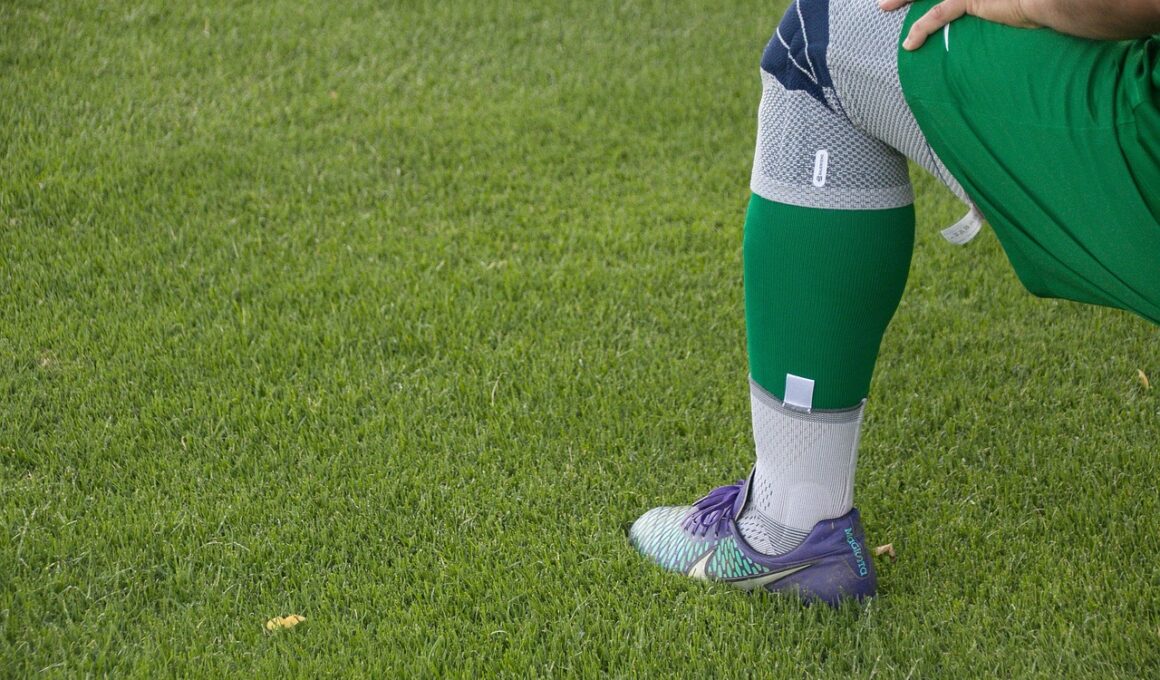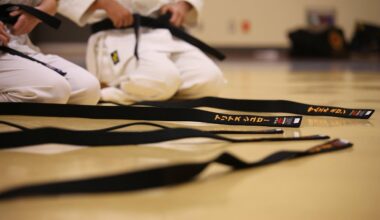Integrating Mobility Drills into HIIT to Avoid Strains
High-Intensity Interval Training (HIIT) offers an efficient workout regimen but can lead to injuries if not approached wisely. Among the most critical factors in injury prevention is integrating mobility drills into your routine. Mobility drills not only enhance performance but also decrease the risk of strains and sprains. These drills prepare your joints and muscles for the high-impact movements typical in HIIT sessions. Including mobility work focuses on improving the range of motion and muscle elasticity, crucial for preventing injuries during demanding exercises. Fitness enthusiasts will find that such drills complement their HIIT workouts effectively—priming the body for subsequent intense activities. Strategies can include dynamic stretching and joint-specific exercises to alleviate stiffness and improve flexibility. Consider a structured approach to incorporating these mobility drills, ensuring they become part of your fitness routine. As you prepare for each HIIT session, prioritize the integration of these activities to enhance your workout efficacy while keeping your body safe. Performing exercises like leg swings, arm circles, and hip rotations can foster the necessary mobility, setting the stage for optimal performance in high-intensity workouts.
The importance of a warm-up cannot be overstated, especially in HIIT workouts. A comprehensive warm-up should precede any high-intensity training to aid prevent injuries. Many individuals underestimate this vital phase, often jumping straight into the intense portions of their workouts. It is essential to remember that your body needs time to acclimatize to the demands of rapid movements. Engaging in a 10 to 15-minute warm-up focusing on dynamic mobility drills can greatly enhance your readiness. These activities engage various muscle groups, increasing blood flow and reducing muscle tightness, thus preparing your body effectively. Additionally, dynamic movements mimic the actions you’ll perform during high-intensity intervals, allowing your body to adapt better to the exercise’s demands. Warm-up routines can include movements like walking lunges, high knees, or torso twists. Each exercise should promote greater mobility and flexibility. Individually tailored warm-ups considering your specific movement patterns contribute significantly to injury prevention. Hence, allocate time for these preparatory phases to ensure your high-intensity efforts yield maximum benefits while minimizing risks.
Target Mobility Drills for HIIT Users
Some mobility drills specifically target muscle groups frequently engaged in HIIT workouts. Focus on exercises that enhance hip, shoulder, and core mobility, as these areas often dictate performance and injury potential. Hip mobility exercises, such as lateral lunges or hip circles, improve your squat depth and functional movement patterns. Similarly, shoulder mobility drills like wall slides or chest openers can enhance your overhead movements, thus optimizing your workout efficiency. Furthermore, don’t overlook the core; incorporating rotational movements helps stabilize your torso during high-intensity exercises. Engaging in these targeted drills enhances the performance of specific HIIT movements, encouraging better technique throughout the workout. Routines can be adjusted to suit your individual limitations and strengths, ensuring personalized mobility enhancements. Regularly integrating these specific mobility drills as part of your warm-up can result in significant improvements in your overall workout performance. Be mindful to assess your mobility levels periodically—progressively adapting your drills to continue advancing flexibility and strength, therefore reducing injury risks during intense exercises.
To optimize the effectiveness of mobility drills in HIIT, practice consistency in your routine. Establishing a habit of performing designated mobility exercises before training sessions will bolster the efficacy of your workouts. The aim is to prioritize these drills rather than perceiving them merely as an addition to your fitness regimen. Allocate time in your training plan for dedicated mobility sessions, recognizing their vital role in injury prevention. Consider scheduling two to three weekly mobility-focused sessions to enhance flexibility and strength. Tracking progress is crucial; create a log to monitor improvements in your flexibility and mobility levels over time. Additionally, benefit from expert guidance such as consulting a trainer or physiotherapist, who can provide personalized recommendations for effective mobility drills. Consistent practice increases your awareness regarding your body mechanics and areas requiring additional focus, further refining your approach to HIIT. As you improve your range of motion and joint function, you will likely notice increased performance in your high-intensity workouts, setting a foundation for long-term adaptation and injury prevention.
Fitness Gear and Mobility
Fitness gear also plays a crucial role in ensuring optimal mobility during HIIT workouts. Selecting the right footwear can significantly impact your performance, providing adequate padding and support during high-impact activities. Shoes designed specifically for HIIT offer stability and traction, allowing you to execute movements confidently. Additionally, consider workout attire; wear comfortable, flexible clothing that allows for uninhibited movement. Avoid constricting fabrics, as they might limit your range of motion during exercises. Compression gear may enhance blood flow to muscles, potentially assisting in warmth during workouts. Such equipment supports muscle function, further encouraging your mobility efforts. Additionally, incorporating props like resistance bands can aid mobility drills, enhancing strength while performing flexibility-enhancing exercises. Bands can increase the range of motion of specific joints, making them valuable additions to warm-ups. Investing in quality equipment tailored to your HIIT routines ensures a more effective workout improving flexibility and overall comfort. Remember, proper gear reflects your commitment to fitness and your understanding of how best to support your body’s needs during high-intensity training.
Adequate recovery is another essential aspect of integrating mobility drills into your HIIT routine. Recovery periods help the body to rebuild and repair after intensive workouts. During these intervals, prioritize active recovery tactics such as light mobility exercises or foam rolling to maintain your body’s flexibility. It isn’t just about the hours you invest in your workouts; rest periods are critical companions to a successful training regimen. After each HIIT session, allocate time to stretch targeted muscle groups and alleviate their tightness by incorporating mobility work. Regular recovery will ultimately prevent chronic tightness, potentially leading to injuries over time. Consider using yoga and Pilates to complement your mobility training, as these disciplines emphasize proper body mechanics and flexibility. Dedicating time for recovery and mobility will yield additional benefits, particularly regarding overall performance improvement and enhancement of your workout quality over time. Being diligent about recovery allows your muscles to recover and prepares you optimally for the next HIIT session. Such approaches contribute not only to injury prevention but also to long-term fitness advancements.
Conclusion: The Impact of Mobility Drills in HIIT
In conclusion, the inclusion of mobility drills into your HIIT routine stands as a cornerstone of effective injury prevention. Prioritizing these exercises fosters improved flexibility and enhances your performance in high-intensity workouts. With dedicated efforts to integrate mobility drills, you can significantly reduce the likelihood of strains and sprains, allowing for consistent training progress. Make use of targeted mobility exercises designed to strengthen and warm up crucial muscle groups, emphasizing areas commonly stressed during HIIT. Remember that your body’s adaptability improves over time, leading to enhanced performance as you consistently integrate these practices. Beyond physical benefits, incorporating mobility work reflects a holistic approach to fitness, valuing your body’s well-being alongside performance goals. Regularly reflecting on your recovery needs and mobility progress will contribute significantly to overall training success. As you commit to consistent mobility training, you gradually enhance your joint health, overall fitness, and ability to perform high-intensity workouts effectively. Thus, adopting mobility drills sets the stage for long-term success, encouraging safer and more fruitful HIIT experiences for every enthusiast.
In addition to the physical aspects, cultivating a mental approach to injury prevention through mobility is equally important. A strong mindset optimized for flexibility and adaptability can positively impact your workout journey. Visualization techniques can reinforce your body awareness, allowing you to predict and avoid movement-related injuries. Fostering a positive attitude toward recovery and mobility practices promotes consistency, making them integral to your training. Remember, respecting your body and its limits is key—listening to your body’s signals can help prevent overexertion and injuries. Emphasize conscious movements during mobility drills, as they enhance your innate body awareness during high-intensity exercises. When practicing these drills, communicate with your body through mindful engagements in each stretch or movement. Such mindfulness not only contributes to muscle relaxation but aids in injury prevention as well. Incorporating mental strategies along with physical drills provides a comprehensive approach to injury prevention in HIIT, shaping the framework for successful training experiences. Consequently, a well-rounded fitness ecosystem that harmonizes mobility, recovery, and a positive mindset can lead to injury prevention success and heightened performance in all aspects of health and fitness.


